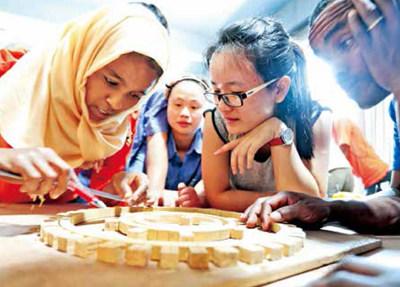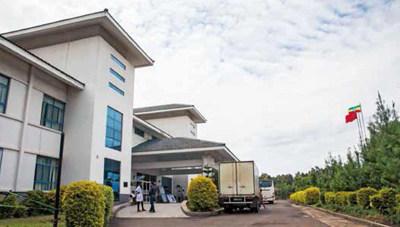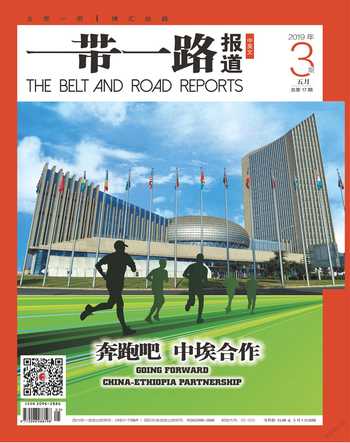民生:在“非洲屋脊”共筑希望
2019-09-10李卉嫔
李卉嫔
People's livelihood: building dreams together on the "roof ofAfrica"

“十年”这个时间段,对埃塞俄比亚来说,有着非同寻常的意义:十年是埃塞义务教育的起点:是彻底消除疟疾的终点;是经济腾飞、GDP平均增长10%的节点,是成为东非第一大经济体的蜕变。
埃塞是非洲最大的竹林国家,竹制品是其重要的外汇来源之一。2018年9月,四川省泸州市纳溪区白节镇,迎未了不远万里而来的38名埃塞俄比亚学员。他们来这里学习竹产品生产加工技艺:将藤条扭成适合的形状,连接接头,切割机去料,纱布打磨等一系列工序下来,小巧的吊灯、台灯,实用的餐垫、精美的竹藤家具便诞生了。师傅手把手教,学生一点一滴学,短短一周时间,埃塞学员进步神速。学员们感慨,没想到竹木藤能做出这么多东西,希望通过这次学习,把优秀的技艺带回家乡。
十年来,从手工艺品、服装、鞋等轻工业品制作,到火车驾驶、铁路运营、飞机驾驶等大型工种,中国有针对性地为埃塞俄比亚开展各种职业技能培训、援建学校。2008年开始投入使用的埃塞一中国职业技术学院是中国援助非洲的最大教育项目。
十年来,中国向埃塞俄比亚派遣教师、捐赠教学设施、提供培训课程,发展职业教育以促进经济发展和人力资源开发,成绩斐然。在埃塞的中国企业为当地人提供技能培训,提供实习机会,埃塞已成为中国援外培训资源的最大受益国之一。
随着两国教育合作愈加紧密,“留学”不再是梦想,越来越多埃塞年轻人选择到中国“圆梦”。操着一口流利普通话的纳必永是一名埃塞留学生。2012年,他在父亲的鼓励下,来到天津大学建筑学院开始本科学业。几年后,对中国文化的喜爱让他继续留下攻读硕士学位。“对我来说,天津大学是我的第二个家,当我18岁来到这里时,还是个懵懂的少年,但当我即将离开时,已对自己有了清晰的人生规划。”纳必永说。
十年前,埃塞俄比亚的中学课本载入了这样的一课:中国在近代也贫穷落后,但近几十年通过勤奋创造了经济奇迹;既然中国能由穷变富,那么我们埃塞俄比亚也能创造经济奇迹。中国奇迹来自其人民都受过基本的教育,渴望用自己的勤奋努力获得更好的生活。这篇课文在埃塞俄比亚青年中产生了极大的震撼,希望学习中国模式、到中国学习的年轻人越来越多。

埃塞俄比亚曾经疟疾肆虐,人民深受其害,为此,埃塞制定了“医疗十年”计划,计划在2030年前彻底消除瘧疾。
十年消除疟疾计划来源于中国对抗疟疾的成功经验:过去十年里,中国在非洲设立了几十个防治疟疾中心,帮助马拉维实现了疟疾零死亡,以清除传染源为核心的中国原创青蒿素复方在非洲很多国家证明了其可行性。
十年消除疟疾计划的完成也与中埃40年医疗合作打下的坚实基础密切相关。
45年前,中国首批援助医疗队来到季马,心血管专家梅庚年担任医疗队队长,期间他的团队攻克了多个医疗难题。次年8月,埃塞俄比亚发生严重旱灾,参与救灾的梅庚年不幸遭遇车祸、以身殉职。他被誉为非洲的“中国白求恩”。埃塞政府在梅庚年墓前立起三座大理石墓碑,以纪念他的国际主义精神。
40多年来,一批批援助埃塞的中国医务人员,踏着梅庚年的足迹,奉献在埃塞俄比亚高原。尤其是在“一带一路”倡议的推动下,中国对埃塞的医疗援助力度越来越大。
2018年8月,在首都亚的斯亚贝巴的中国一埃塞俄比亚友好医院,来自河南省平顶山市第二人民医院的外科副主任医师张天鹏正在与当地医生沟通患者的病情。时年37岁的他随中国援埃塞第20批医疗队在这里已经工作一年了。

张天鹏说,“这一年的经历对我一生都是一种很难得的历练。”走在医院会有人突然说“你好!” “China!”。有一次手术做到一半,发现后面围了一圈当地的医生在拍照观察。“也有家属紧紧地握着我们的手,虽然很多当地话我们听不懂,但能看出他们眼神中带着由衷的感激。”张天鹏回忆道。
一年多里,张天鹏所在的这支医疗队在受援医院共开展各类手术512台次:日常门诊病人共11647人次;麻醉386人次;×光检查11151人次,B超检查9759人次,化验检查1370人次,针灸治疗9356人次,带动了埃塞医疗水平的提高。
埃塞卫生部国务部长凯贝德·沃尔库表示,“中国帮助我们健全完善了医疗体系,援建了现代化医院,并配备药品和急需的医疗设备,我们期待着更多的双边合作。”
十年教育铸魂,十年医疗强身,前者为发展指路,后者为发展护航。未来十年,还有更多如梅庚年、张天鹏一样的中国医生将奉献于埃塞俄比亚高原,为其无数个十年医疗计划的如期完成添砖加瓦。
For Ethiopia, a decade implies particular importance.In the past decade, the country has witnessed itseconomic take-off, with its annual GDP growth reaching10%; in the upcoming decade, it will fulfill its medicalplan to eliminate malaria; one decade also represents thetime span forits compulsory education.
Education: "we can also create miracles"
Etlriopia has the largest bamboo forests in Africa,with bamboo products as one of its important sourcesof foreign exchange. In September 2018, Baijie Town,Naxi District, Luzhou Sichuan, embraced 38 Ethiopianapprentices who came from afar to learn the productionand processing skills of bamboo products, fromwrenclung rattan into desired shapes to connectingwith joints, from deflashing with cutters to polishingwith abrasive paper. From such small ornaments asceiling lamps and table lamps to practical placematand exquisite rattan furniture, the masters taught thestudents hand by hand, while the students learned littleby little. In such a short period of one week, theseEthiopian students made rapid progress. The studentssighed with emotion that they never thought they couldmake so many objects with rattan, and hoped to bringback excellent skills through this training session.In the past decade, from the production of suchlight industry products as handicrafts, apparel, andfootwear to such major professions as the operationof trains, railways, and aircrafi, China has providedvarious kinds of vocational skill trainings to Ethiopiaand assisted in building schools there. Ethio-ChinaPolytechnic College, which has been in operation since2008, is the largest education project aided by China inAfrica.
During the past decade, China sent teachers,donated teaching facilities, and provided trainingcourses to Ethiopia, aiming to boost the developmentof economy and human resources by developingvocational education, which has recorded remarkableachievements. Chinese enterprises in Ethiopiaalso provided locals with skill trainings and internopportunities, making Ethiopia the largest beneficiaryofChina's training resources for foreign countries.
With the closer cooperation in education betweenChina and Ethiopia, "studying abroad" is no longeronly a dream for Ethiopians, and more and moreEthiopian youngsters choose to "fulfill their dreams" inChina. Nabiyong, who speaks Mandarin fluently, is anEthiopian student in China.Encouraged by his father,he came to pursue his bachelor's degree in the Schoolof Architecture, Tianjin University. As interested inChinese culture, he continued to study for the master'sdegree a few years later. "For me, Tianjin University ismy second home. When I came here at 18 years old, Iwas still an innocent teenager, but when I am about toleave here, I have a clear life plan,"said Nabiyong.
Ten years ago, there was a lesson in the text bookfor secondary school students in Ethiopia, which read:China used to be a poor underdeveloped country inmodern times too, but has created economic miraclesthrough diligent work in recent decades; as long asChina can develop from a poor country to a rich one,then Ethiopia can also create economic miracles.China's economic miracles result from the fact thatmost of its people have received basic education, andare eager to live a better life through hard work. Thistext shocked many Ethiopian youngsters, and thenan increasing number of them hoped to learn fromChina's development mode and study in China.
Medical care: fighting against malaria and
safeguard health
Ethiuopia was once a malaria-endernic countrywith its people deeply suffered. Therefore, Ethiopiaprepared a "ten-year" medical plan namely the plan toeliminate malaria before 2030.
The "ten-year" malaria elimination plan comesfrom China's successful practice of fighting againstmalaria: in the past decade, China has set up dozensof malaria prevention centers in Africa, helpingMalawi realize the goal of zero death from malaria;"China's malaria prevention program", the core ofwhich is using artemisin in compound to eliminateinfection sources, has proved its feasibility in manyAfrican countries.
The completion of the "ten-year" malariaelimination plan is closely related to the solidfoundation laid by the 40-year China-Ethiopiamedical cooperation.
45 years ago, the first Chinese medical aid team,which was led by angiocarpy expert Mei Gengnian,came to Jimma. During their stay there, the teamovercame many medical difficulties. In the nextAugust after their arrival, Ethiopia was hit by severedrought. Mei Gengnian participated in the disasterrelief, and unfortunately died at his post in a caraccident. He has been reputed as "Chinese Bethune"in Africa. The Ethiopian government set up threemarble tombstones in front of Mei Gengnian's tombto commemorate his spirit of intemationalism.
Over the past over 40 years, groups of Chinesemedical aid workers followed the footsteps of MeiGengnian, devoting themselves on the EthiopianHighlands. Especially with the boost ofthe Belt andRoad Initiative, China is providing more and moremedical aids to Ethiopia.
In August 2018, in the Ethio-China FriendshipHospital in Addis Ababa, the capital of Etluopia,Mr. Zhang Tianpeng, associate chief surgeon fromPingdingshan the Second People's Hospital ofHenan was talking about patient's conditions withlocal doctors. He, 37-year-old at that time, had beenworking with the 20th batch of the Chinese medicalteam in Ethiopia for one year.
Zhang Tianpeng said, "This is a valuableexperience in my life." When he was walkingin the hospital, someone would suddenly say"Hello!""China!". Once when he was performingan operation, he found himself surrounded by localdoctors who were taking photos and observing."Some patients' family members would hold ourhands tightly. Although we cannot understand manylocal words, we can see the gratitude in their eyes:'Zhang Tianpeng recalled.
In the past year, the medical team which ZhangTianpeng belongs to has performed 512 0perations inthe aided hospitals; received 11,647 person-times ofroutine outpatients; anaesthetized 386 person-times;performed X-ray examinations for 11,151 person-times;performed medical ultrasound examinations for 9,759person-times; performed laboratory examinations for1,370 person-times; acupunctured 9,356 person-times,improving the medical services in Ethiopia.
Kebede Worku, State Minister of Health ofEthiopia, said, China helps us improve our medicalsystem, aids the construction of modem hospitals,and supplies medicines and medical equipmentneeded badly. We are looking forward to morebilateral cooperation.
A decade of education aid shapes the soul, and adecade of medical aid improves physical fitness. Theformer shows the direction of development, whilethe latter guarantees the development. In the comingdecade, there will be more doctors like Mei Gengnianand Zhang Tianpeng devoting themselves on theEthiopian Highlands, and helping Ethiopia completeits several "ten-year" medical plans.
